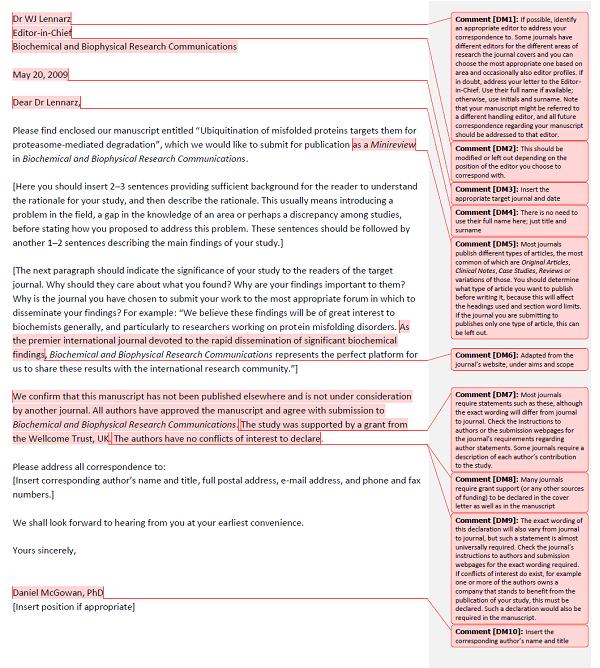博文
投稿信:推销你的稿件
||

出版空间以及编辑关注度的竞争异常激烈。将原稿投送给杂志编辑,附上一封信“原稿请见附件”是远远不够的。投稿信是你与拟投杂志直接交流的机会。除了写明你的研究与众不同外,还应直接向总编辑说明为什么你的发现很重要及其应该在此杂志上发表的理由。
投稿信应含有几个重要内容。具体内容可通过 http://www.liwenbianji.cn/coverletter 链接下载。大家可根据批注中的建议起草你自己的投稿信,选择提出的句子类型替代括号中的句子。投稿信的格式几乎适用于所有投稿;当然,某些类别的论文需要加入额外的内容。例如,关于临床试验数据的存储信息通常需要附上一份临床试验报告,提供你的序列数据进入公共数据库的信息。
查阅目标杂志的《稿约》是每篇稿件的既定程序,其中很可能含有投稿信必须写入的内容。另外一个信息来源是杂志的投稿网页。尽管以下列出的内容以及关于“Edanz投稿信模版”中描述的内容不一定完全都是这些目标杂志所要求的,但所有这些都是投稿信中必不可少的,因为这样做可引起编辑对你的关注。以下方法适用于投稿信的撰写:
• 一些杂志根据其刊出文章领域的不同进行编辑分工,你可以根据不同的领域,有时也可根据编辑的专业背景选择最合适的编辑。直接称呼收信编辑,如:“Dear Dr. Smith”。如果不能找到合适的编辑,可将投稿信写给总编辑。
• 信的开头应写出文章题目,希望文章在杂志的哪一个栏目或作为哪一个文章类别发表,以及投稿杂志的名称。
• 之后简单叙述研究背景与理论基础,说明研究目的以及开展的工作。然后简单描述研究成果。
• 接下来的段落很重要。你需要向研究界解释你的发现的意义,特别是对杂志读者的意义。如果你不能解释为什么该杂志读者会对你的发现感兴趣,你需要选择另一家更合适的刊物,因为编辑只将他们认为会引起读者兴趣的文章送同行评议。研究一下你准备投稿杂志的“目标与刊出范围”会对你有帮助。
• 投稿信的最后一段应包含杂志所要求的声明或说明。这些通常包括关于利益冲突、基金资助与资助来源的声明,以及所有作者已阅读过并同意文章的内容以及未一稿多投的声明。每个作者的作者资格确认也是需要的。
• 最后,留下详细的通讯方式以及礼貌的结束语。
示例:

英文原文:
The cover letter: your sales pitch
Competition for publication space and for editors’ attention is now very high, and it is no longer sufficient to send a manuscript to a journal editor along with a letter saying little more than “please find my manuscript attached”. The cover letter is your opportunity to directly address the editor of your target journal. It can be used to set your study apart from others and directly explain to the editor why your findings are important and why they should be published in their journal.
There are a number of important components of a cover letter, all of which should be included. These components are described in detail in Edanz Cover Letter Template, which can be downloaded from: http://www.liwenbianji.cn/coverletter
This template can be used to develop your own cover letters by following the suggestions in the comments and replacing the bracketed sentences with the types of sentences explained. The format of this letter is applicable for most if not all submissions, although additional sections may be required for some types of paper; for example, information about deposition of clinical trial data would most likely need to accompany a report of a clinical trial, and information about the deposition of sequence data into public databases would possibly need to be provided where such data has been obtained.
As always, the target journal’s instructions to authors should be consulted; these will most likely outline the information that absolutely must be included in the cover letter. Another source of this information is the journal’s submission webpages. Although not all of the components listed below and described in the cover letter template will be described as required on the target journal’s webpages, all should be included in your letter, because to do so will increase your chances of grabbing the editor’s attention. The following principles apply to cover letter development:
• Some journals have different editors for the different areas of research the journal covers and you can choose the most appropriate one based on area and occasionally also editor profiles. Address your letter personally to the appropriate editor, e.g., “Dear Dr. Smith”. If one cannot be readily identified, address your letter to the editor-in-chief.
• Begin by providing the title of your manuscript, the section/publication type you would like to see it published as, and the name of the journal you are submitting it to.
• You then need to provide a very brief background and rationale for your study, explaining why you did what you did. This can be followed by a brief description of the results.
• The following paragraph is very important. You will need to explain the significance of your findings to the research community, and specifically to the readers of your target journal. If you find it difficult to explain why the readers of that journal would be interested in your findings, then you may need to select a more appropriate journal. Editors will only send papers to review that they think will be of interest to their readers. Studying the ‘aims and scope’ of your chosen journal might help with this.
• The last paragraph of the letter should contain any statements or declarations required by the target journal. These usually include declarations of any conflicts of interest, grant support or other sources of funding, a statement that all authors have read and approved the manuscript and a statement that the same manuscript has not been submitted elsewhere. Confirmation of each author’s qualification for authorship may also be required.
• Finally, include details for correspondence and a polite farewell.
Example:

Dr Daniel McGowan
分子神经学博士
理文编辑学术总监
https://blog.sciencenet.cn/blog-288924-499508.html
上一篇:摘要与关键词
下一篇:选对期刊